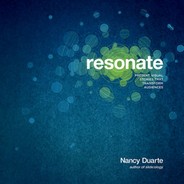14 Resonate
You can have piles of facts and still fail to resonate. It’s
not the information itself that’s important but the emo-
tional impact of that information. This doesn’t mean that
you should abandon facts entirely. Use plenty of facts,
but accompany them with emotional appeal.
There’s a difference between being convinced with logic
and believing with personal conviction. Your audience
may agree with the thought process you present, but
they still might not respond to the call. People rarely
act by reason alone. You need to tap into other deeply
seated desires and beliefs in order to be persuasive. You
need a small thorn that is sharper than fact to prick their
hearts. That thorn is emotion.
Facts Alone Fall Short
consumer need. Suddenly, irrelevant objects became
powerful symbols of status.
Today, appealing to emotion is commonplace. Ads can
make us laugh or cry, feel sexy or feel guilty. A full range
of emotions can be felt during one thirty-minute televi-
sion show. Even restaurant menus tantalize us with food
that will make us feel decadent, surprised, or enraptured.
We can’t escape it.
So today more than ever, communicating only the
detailed specifications or functional overviews of a
product isn’t enough. If two products have the same
features, the one that appeals to an emotional need
will be chosen.
Aristotle said that the man who is in command of persua-
sion must be able “to understand the emotions—that is,
to name them and describe them, to know their causes
and the way in which they are excited,” and that “persua-
sion may come through the hearers, when the speech
stirs their emotions.”
3
Consumers are accustomed to emotional appeal, and
they are most certainly ready to respond emotionally to
a presentation. So why don’t we present emotion? It’s
uncomfortable. It’s an especially tough skill for analytical
professionals to adopt. It’s easy to think, “I don’t get paid
at work to feel, I get paid to do.” And that’s true. But if
your team isn’t motivated to move forward or your cus-
tomers aren’t motivated to buy, then you are in trouble.
Including emotion in a presentation doesn’t mean it
should be half fact and half emotion. It also doesn’t mean
there should be boxes of tissue under each seat. It simply
means that you introduce humanness that appeals to the
desires of the audience. It’s not that difficult to evoke a
visceral reaction in an audience if you use stories.
“The problem is this: No spreadsheet, no bibliography
and no list of resources is sufficient proof to some-
one who chooses not to believe. The skeptic will
always find a reason, even if it’s one the rest of us
don’t think is a good one. Relying too much on proof
distracts you from the real mission—which is
emotional connection.”
Seth Godin
2
At some point in your life, you’ve had your emotions
aroused. You’ve experienced a chill down your spine or
a sick feeling in the pit of your stomach. When some-
thing resonates emotionally, you feel it physically.
Currently, emotion is a powerful driver of consumer
behavior, but it didn’t used to be. Before the 1900s,
people rarely expressed emotion publicly; it was not
socially acceptable to discuss feelings or desires.
Products developed were solely marketed as items of
necessity, not items of desire. As PR and advertising
became prevalent, companies began to compete
based on consumer desire and not necessarily
CH001.indd 14CH001.indd 14 8/17/10 4:11:48 PM8/17/10 4:11:48 PM
Why Resonate? 15
“The public is composed of numerous groups
whose cry to us writers is: ‘Comfort me.’ ‘Amuse
me.’ ‘Touch my sympathies.’ ‘Make me sad.’
‘Make me dream.’ ‘Make me laugh.’ ‘Make me
shiver.’ ‘Make me weep.’ ‘Make me think.’”
Henri René Albert Guy de Maupassant
4
CH001.indd 15CH001.indd 15 8/17/10 4:11:48 PM8/17/10 4:11:48 PM
..................Content has been hidden....................
You can't read the all page of ebook, please click here login for view all page.
